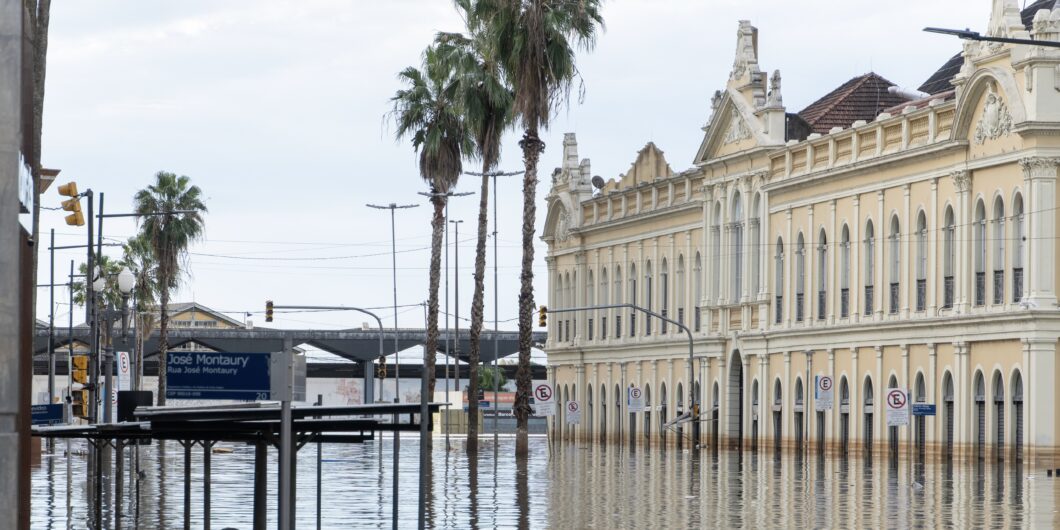The representational theory of capital offers a more nuanced understanding of what capital is, and what role it plays in economic life.
Learning from Preventable Tragedy
I was born in Porto Alegre, Brazil. Porto Alegre is in front of Lake Guaiba, which is formed by five rivers. In 1941, it suffered a tragic flood. Lake Guaiba rose almost sixteen feet above average, and a quarter of the population lost their homes. The trauma of such an event led the federal, state, and local governments to build dikes, walls, and pump systems to protect the city from a “once-in-a-hundred-year event.” According to the estimate, dikes and walls twenty feet tall would offer such protection.
Since 1941, there have been many other storms and floods, but the investments, which I would guess are in the ballpark of one billion dollars, were sufficient to prevent significant damage until two weeks ago. In early May 2024, torrential rains raised the Guaiba waters to a record of eighteen feet. The floods upstream and in the Guaiba Lake killed hundreds, left more than six hundred thousand homeless, and destroyed infrastructure and other capital goods statewide.
In Porto Alegre, the flood protection system failed miserably; one-third of the city is underwater, the airport is closed indefinitely, and the town was left with just one land connection with the rest of the country. Two weeks after all this started, the distribution of water and electricity has not yet returned to most of the city, and tens of thousands are homeless.
Why did the flood protection measures fail? There are many different reasons, but in the big picture, misaligned incentives within government led to catastrophic failure and tragedy. We do not yet know the full extent of the tragedy, but in hindsight, it seems evident that the tragedy was to be expected.
In the aftermath of the 1941 disaster, there was a sense of urgency about addressing the problem and preventing another such tragedy. That contributed to the lobbying power of construction companies, enabling the system to be built. Unfortunately, over time, the memory of the 1941 flood was lost. No longer pressed by any powerful lobby, the city counselors neglected to adequately fund the upkeep of the dikes, walls, and pumping stations.
For a time, civil servants were still officially in charge of that service, even though their budget was inadequate. Then a too-clever-by-half mayor proposed abolishing the department in charge of the system’s upkeep, transferring its attributions to the entity that produces and distributes potable water in the city and maintains the sewage, drainage, and, from that moment on, also flood prevention. It sounded to him like a good idea because that public-owned utility is funded with a fee on water consumption. Instead of maintaining the flood protection system through taxes duly voted by the city council, they could be funded through a cross-subsidy. Out of view, out of mind, the necessary investments were not made, and the system quietly eroded. But everybody was happy until tragedy struck, and people started to ask how that happened.
Porto Alegre has two-thirds of the city area zoned for agriculture or nature preserves, which makes it out of bounds for urban development. This means low-income people have no alternative but to remain in the floodplain.
What has just happened in Porto Alegre may serve as a cautionary tale about the many ways collective action may go awry. No politician simply decided to build a faulty flood prevention system, or to allow the existing one to decay. But the incentives to design and build a sound system, in keeping with the criteria defined in the original study, were not there. Indeed, insofar as proper design costs money, both contractors and politicians had strong incentives to cut corners. Inspectors were not always aware of technical reasons for some requirements, and just in general, few people were paying attention. The situation with the maintenance is even more tragic. It was entirely predictable that leaving such an important matter to a minor office with other responsibilities, to be funded by a hidden charge on the water bills, would prove a recipe for a serious breakdown in the system.
If this is an accurate interpretation of the events, what lessons of universal value can we draw from them?
The mistakes that led to the failure in this case, combined with broader reflections on human behavior, can point towards better principles for public governance. These principles must be informed by much more than the narrow events described above. They need to consider reflections on proper human behavior.
One interesting way of approaching the problem is by considering how one might go about rebuilding Porto Alegre. To answer that question, we need to consider which would be more economical: rebuilding in the same places where the damaged buildings once stood, with effective protective measures, or rebuilding elsewhere and leaving the low areas for temporary uses such as parks.
Here we encounter a truly problematic epistemological question. I doubt anyone can know how to calculate this if we do not put a “price” on building on a floodplain. There are many ways to do that. An obvious one is to require anyone with a house, a shop, or a warehouse built on a floodplain to buy flood insurance in the private market. That seems a good way to put a “price” on such a decision. Any American living in a floodplain knows this, despite the distortions created when flood insurance in the US was nationalized.
Next, let us consider which principles should inform the ways to fund whatever protection against floods should exist. Here another problem becomes evident: the flood protection system was treated as a public good. This largely explains the misaligned incentives discussed above. If the local government farmed out the service to private companies, who were compensated by a fee charged to the residents and businesses of the protected areas, it is far more likely that building and maintenance would be done properly. This is so precisely because flood protection is not a true public good; that is, its benefit is not diffused; it can be measured, the beneficiaries identified, and a price charged for its provision. That is the lesson of universal application.
The less efficient the protection those companies provide, the more expensive the premiums to pay for the flood insurance, and vice versa. So, the residents and businesses of the protected areas will be financially incentivized to demand that local government collaborate with efficient companies to provide those services.
The design of these arrangements I have in mind is similar to the ones used for trash collection, with the difference that the residents and businesses do not pay a monetary penalty for failing to demand efficient trash collection, as they would under the proposed system in the form of the flood insurance premiums.
I have no idea if people under these conditions would move to areas with higher elevations. Presumably, they would weigh the cost of remaining in their previous locations against the cost of developed land in higher elevations, which varies significantly from place to place. Porto Alegre, for instance, has two-thirds of the city area zoned for agriculture or nature preserves, which makes it out of bounds for urban development. This often means that low-income people have no alternative but to remain in the floodplain. Revising the zoning laws could open other options for them.
That points to yet another problem of collective action. As the researchers of the ILD in Peru concluded many years ago, the cost of operating in the “formal” sector determines the size of the “informal” sector. That is a simple application of the logic of thinking at the margin. The same sorts of calculations affect people’s decision whether to live in a floodplain near the existing jobs and urban infrastructure, or on a highland far from everything. If there are “artificial” (legal) barriers to developing certain lands for urban use, people may make choices that would otherwise be imprudent or just inefficient.
All of this changes if people pay the real costs of private goods that, at first glance, look like public goods. In this case, instead of paying for flood protection with taxes collected from people not directly affected by the flooding, they could have charged the beneficiaries of such infrastructure more directly. This would not only solve the problem of economic allocation, but would do so in the fairest mode possible.
Some may complain that I lack compassion with the unfortunate flood victims. I disagree, but this is not the place to argue about that. I will say that hard cases make bad laws. Here is yet another lesson that should inform our views of collective action: solutions that are needed in emergencies should not rule society in normal times.
Rebuilding from tragedies like the one that just happened in my hometown, as efficiently and reasonably as possible, will require a decision to internalize the price of people’s decisions about where to live and work. This will create incentives for proper investments in flood prevention. As in any other case of collective action, the solution lies in expanding people’s freedom, and expecting them to pay the real costs for what they want.



